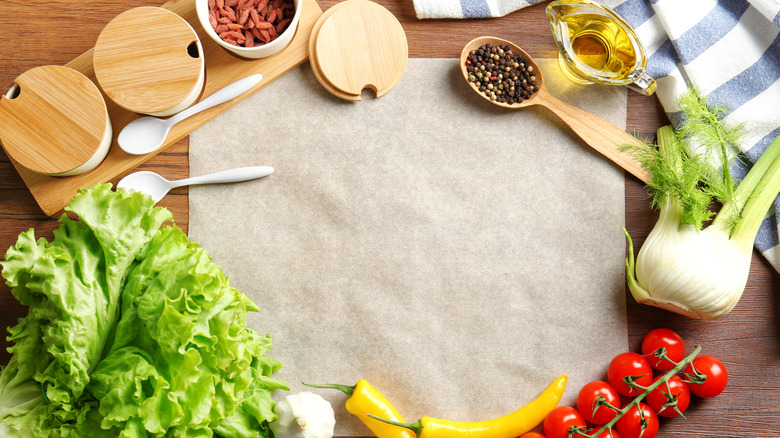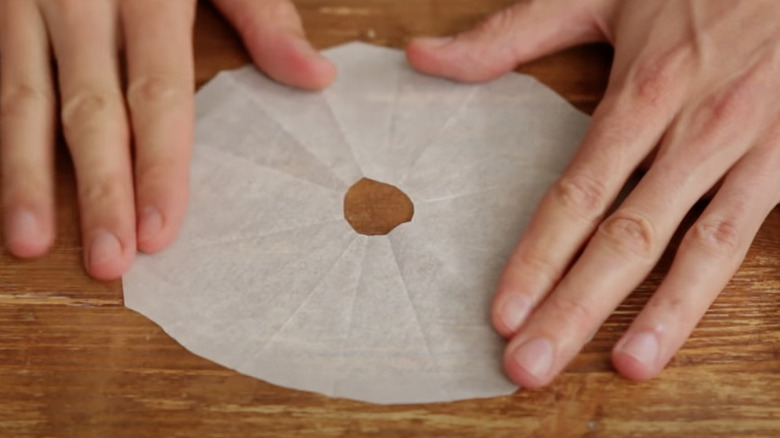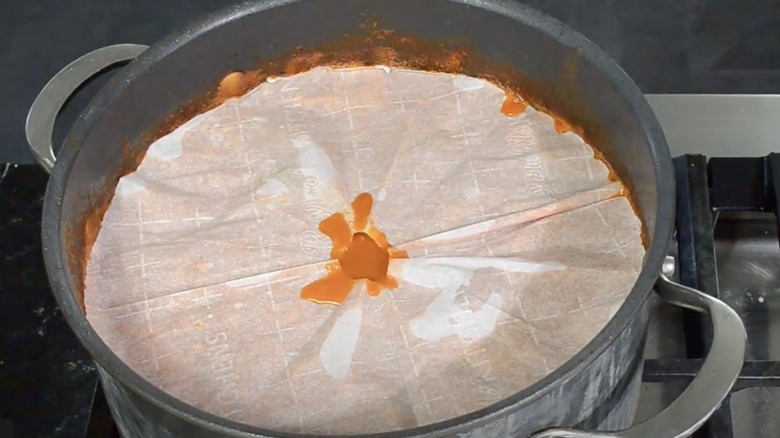How A Parchment Paper Cartouche Can Help Food Cook More Evenly
An assumably high number of people might be asking, "What the heck is a cartouche, and why should it reside in m kitchen?" But before explaining what this somewhat obtuse cooking tool is, let's first talk about what it's not. The word cartouche can describe different things, and the items couldn't have anything less in common if they tried. Just rest assured, we are not asking you to drag an Egyptian monument marker into your home.
The oldest and most recognized use of the word cartouche, at least among archaeological enthusiasts, is to describe an oval-shaped frame containing Egyptian hieroglyphs, explains Britannica. It typically represents the name of a sovereign or deity and is mounted on a monument – definitely not related to modern-day cooking. Next up is the word cartouche being used to describe a gun cartridge, according to Science Focus. Bullets do not belong on your stovetop or in your oven. Finally, there's the culinary cartouche, a round cutout of food-grade parchment paper that ensures evenly cooked food with little effort on your part. That's the one you want.
British home chefs typically use a cartouche for lining the bottom of pie and cake pans, notes MasterClass, but French chefs pull it out for lidded techniques such as poaching, glazing, steaming, and braising, especially for stews, sauces, slow-cooked vegetables, meats, fish, and even poached fruits. The parchment-paper cartouche sits atop the pan or the food, replacing a standard metal lid. There's a reason for that.
Cartouche your way to steamy perfection
As Cook's Illustrated demonstrated, a metal lid traps heat energy and reduces the amount of steam as it condenses unevenly beneath the lid. When cooking glazed carrots with a metal lid, it led to varying cool and warm spots and ultimately uneven cooking. It also slowed down the cooking and evaporation process and prevents browning. A paper cartouche, on the other hand, allowed small amounts of steam to seep in equal portions through the round edges, resulting in consistently cooked carrots with the desired amount of glaze. The key is the even distribution of heat and steam, which is unobtainable with standard lids, even when partially covering the food.
Finding a pre-made cartouche can be challenging. But it's easy to make one yourself, which is ideal for fitting specifically to your pan. MasterClass provides step-by-step illustrated instructions for making a cartouche using simple parchment paper, multiple folds, and scissors for tailored trimming. The YouTube channel for Jamie Oliver showcases a one-minute demonstration by French Guy Cooking that employs similar folding techniques and explains that cutting a small hole in the middle allows more steam to escape.
More culinary uses for a cartouche
Many chefs advocate a cartouche for making sauces, gravies, and other creamy stovetop deliciousness, but there's no need to limit the potential for this French-inspired cooking technique. Feel free to experiment with your own recipes, using a cartouche to transform or alter the texture of basic dishes. You can even use the method inside your oven, like in the Cartouche Baked Apple recipe from Tastemade. It uses two cartouches instead of one, utilizing the first at the bottom of the pan and the other atop the food.
The cooking for this recipe starts on the stovetop using an ovenproof pan with a thin coating of melted butter beneath the first cartouche. The addition of ingredients, as well as sautéing and caramelizing, take place on top of the bottom cartouche, and the second cartouche tops it all before getting popped into the oven for the grand finale.
MasterClass suggests using a cartouche in place of a metal lid for making well-known dishes such as rice pilaf, ratatouille, sauce velouté, and braised short ribs or chicken legs. Food52 provides a recipe for poached fish using a cartouche to keep the liquid from evaporating too rapidly, resulting in a moist, evenly cooked plate of freshness from the ocean, lake, or river.


